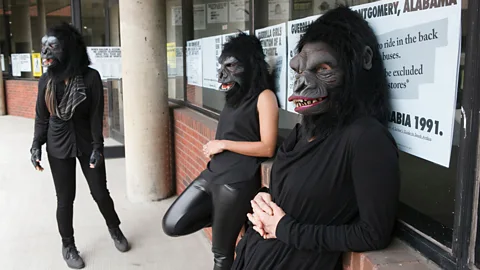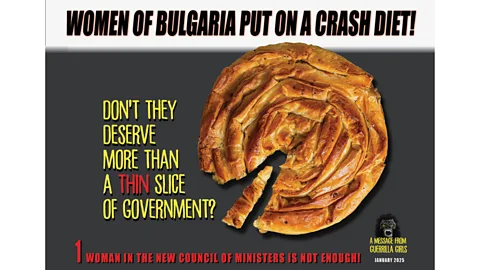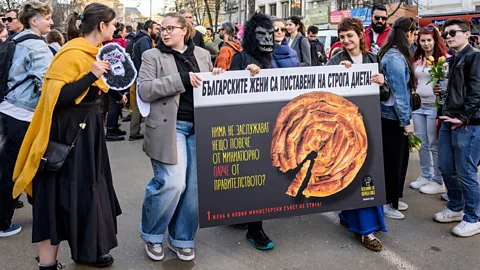The naked billboard that shocked the establishment – and blazed a trail in the art world
 Guerrilla Girls
Guerrilla GirlsIt's been 40 years since the controversial activist group Guerrilla Girls formed. Their most powerful campaign, the "naked poster", broke new ground – and has had a lasting influence.
On a Sunday morning in New York in 1989, a few women perused the permanent collection of the Metropolitan Museum of Art. Hidden among the regular punters, the anonymous feminist art collective, the Guerrilla Girls, went unnoticed as they carefully counted the number of female artists versus the number of naked women depicted in the artworks. They were on a secret mission to make people care about the racial and gender unfairness of the art world.
 Guerrilla Girls
Guerrilla Girls"The idea always was to find that kernel that was unforgettable," one of the founding members of the Guerrilla Girls, who uses the alias Käthe Kollwitz, tells the BBC at the National Museum of Women in the Arts, ahead of an exhibition that celebrates 40 years of their work.
They made their way through the different rooms – past the male nudes of ancient Greece and the near absence of nudity in the early Christian sections – but it was when they hit the early modern era that they found the statistics that would lead to their biting criticism of the art world. They posed the question of who was allowed to be subject and object in the lofty corridors of the world's most prestigious art institutions.
"Less than 5% of the artists in the Modern Art Sections are women, but 85% of the nudes are female," reads the poster, next to a female nude whose head is covered by the group's trademark gorilla mask. The figure is based on the painting La Grande Odalisque, 1814, by male painter Jean-Auguste-Dominique Ingres.
To this day, the group remains anonymous, and when the BBC interviews Kollwitz, she is wearing the mask. "I don't think anyone who actually looks at that poster can go into a museum and not think about what is on the walls and why," she says.
 Andrew Hinderaker
Andrew HinderakerThe Do Women Have to Be Naked to Get into the Met Museum? poster was meant to have been a commission from the New York Public Art Fund, but on seeing the final result, the funding was pulled. The Guerrilla Girls committed to their message and put it on billboards and buses themselves. "We decided to buy space on NYC buses. We also pasted it up ourselves on NYC streets."
The poster threw the collective into the spotlight and cemented their style with a mass audience. The mix of humour, statistics and bold advertising slogans was the culmination of several years of working out how to tackle gender and racial inequality. The group's initial two posters – What Do These Artists Have in Common? and These Galleries Show No More Than 10% Women Artists or None at All – were plastered on walls, street lamps and telephone booths in New York, with no need for permission from the decisions of those who ran the powerful art institutions.
The Guerrilla Girls' decision to adopt the language of advertising was in reaction to what they saw as the ineffectiveness of traditional protests. The group formed in 1985 after attending a protest outside the Museum of Modern Art in New York the previous year. The International Survey of Recent Painting and Sculpture had only featured 17 women and eight artists of colour out of 169 artists.
"A couple of us went to this protest, and it was so clear nobody cared. Everyone just went inside the museum. You know, all these signs about women's art. They didn't believe it for a minute. And that was really the 'aha' moment."
 Getty Images
Getty ImagesThe "Naked" poster, as Kollwitz refers to it, was a game-changer. "We often have crazy visuals, facts, and humour – things to draw them in – and if you actually look at our posters, you'll never see art quite the same way again."
'Undeniable change'
Author and podcaster Katy Hessel, in her book The Story of Art Without Men, points to how artists coming up through the '80s had all grown up with televisions in their homes. "Playing with the media (and art history's) stereotypes of women, they took back control of the gaze and turned it upon themselves."
"The Guerrilla Girls brought public attention to the inequalities and systematic discrimination in the art world, and ultimately asked – just how did museums get away with celebrating the history of patriarchy instead of the history of art?"
From being an outside force pushing for space, their text-based work now often hangs in the very places they once sought to provoke. Their continued anonymity is another invitation to remember women artists who struggled in their time. All the founding members are art professionals in their own right, but as the Guerrilla Girls, they carry the pseudonyms of deceased artists like Frida Kahlo and Zubeida Agha.
"More than being anonymous, it's the way they do it that is also really clever," says Michael Wellen, a senior curator at Tate Modern in London, which has an ongoing free collection of their work on display. "There's a moment of education every time you're figuring out who you're talking to." Since their original counting of nudes in the Met, the art world has changed. But inequity between artists of colour and women in comparison to white men still exists. This can be seen not just in who hangs on the walls but in other areas of the art market. For example, artwork by women only accounts for 39% of gallery sales, according to a report by Art Basel in 2024. Recent studies also point out that permanent collections in major US galleries are 85% white and 87% male. In the UK, it was only in 2023 that the Royal Academy in London displayed Marina Abramović's lifetime of work – making her the first woman to have a major solo exhibition in their main galleries.
 Guerrilla Girls
Guerrilla Girls"I think that there's undeniable change in how museums represent the history of art and contemporary art – and in large part, it's due to the light that the Guerrilla Girls have shone on these inequalities," says Wellen.
While the poster protest was originally critiquing who was allowed to hang on the walls of museums and galleries, this focus has evolved for the Guerrilla Girls as well as for other artist activists, who are now scrutinising how funding is secured and where donors earn their money. In 2019, US art photographer and activist Nan Goldin staged a protest at the Guggenheim, dropping thousands of prescriptions into the atrium in protest against the museum accepting donations from the Sackler family, who own Purdue Pharma, the makers of prescription painkiller OxyContin, which has been blamed for fuelling the US opioid crisis. The protest featured in the documentary The Beauty and the Bloodshed.
The Guerrilla Girls' work has also evolved to take on broader issues, tackling environmental concerns and expanding their signature style globally over the years. The founding members operate like a cell and have collaborated internationally, with approximately 60 contributors across Asia, Latin America and Europe. In March this year, they created a poster with the Bulgarian Women's Fund. Don't They Deserve More Than a Thin Slice of Government? criticised the lack of women's representation in the country's government.
Tracking progress is difficult. Over the years, the Guerrilla Girls have revisited the poster that threw them into the spotlight, conducting recounts. It's a jarring commentary on how little things can change despite public pressure. Between 1989, 2005, and 2012, the number of female nudes in the Met decreased – but the number of women artists actually shrank. Of course, this isn't indicative of every institution, but as always with their work, the message is clear: there is still more to be done.
 Rosina Pencheva
Rosina Pencheva"I chose her because she was a political artist, and that's what I consider the Guerrilla Girls and myself as well," says Kollwitz, when asked why she named herself after the German artist. Born in 1867, the real Käthe Kollwitz's work focused on women, and was profoundly anti-war. Stylistically her work is very different from the Guerrilla Girls, but the thematic content overlaps.
The Guerrilla Girls remain active, and crossing the 40-year threshold is a moment for reflection – but also a time to look ahead. You might expect someone who has been battling injustices for decades with snail-like progress to be exhausted, but Kollwitz says the challenge of progress is what inspires the collective. In November, they will exhibit at the Getty Research Institute in Los Angeles, and a graphic novel is in the works. “We will never stop making trouble,” she says. "Our fight is not over."
Guerrilla Girls: Making Trouble is at the National Museum of Women in the Arts, Washington DC until 28 September.
--
If you liked this story, sign up for The Essential List newsletter – a handpicked selection of features, videos and can't-miss news, delivered to your inbox twice a week.
